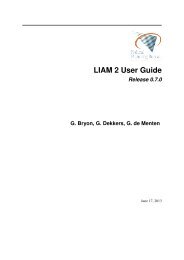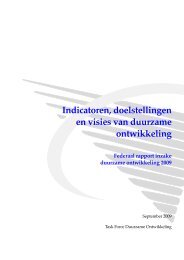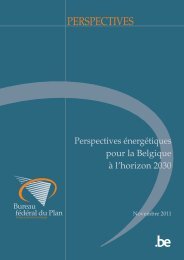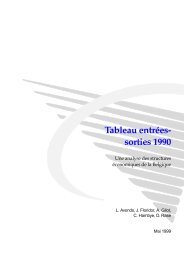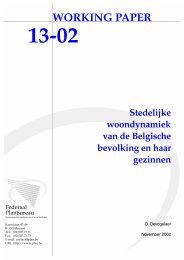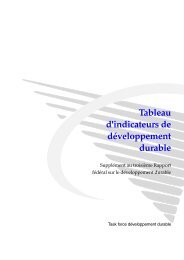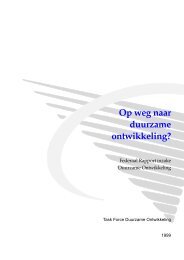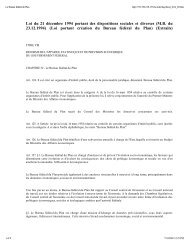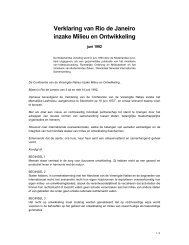long-term care use and supply in europe: projections for germany ...
long-term care use and supply in europe: projections for germany ...
long-term care use and supply in europe: projections for germany ...
Create successful ePaper yourself
Turn your PDF publications into a flip-book with our unique Google optimized e-Paper software.
LONG-TERM CARE USE AND SUPPLY IN EUROPE | 19<br />
gett<strong>in</strong>g <strong>in</strong> or out of bed). The ADL variable has been recoded <strong>in</strong>to four categories: 0 limitation, 1<br />
limitation, 2 limitations, 3 or more limitations. A similar procedure has been <strong>use</strong>d to construct the IADL<br />
variable. It is based on seven items: 1. Us<strong>in</strong>g a map, 2. Prepar<strong>in</strong>g a hot meal, 3. Shopp<strong>in</strong>g <strong>for</strong> groceries,<br />
4. Mak<strong>in</strong>g telephone calls, 5. Tak<strong>in</strong>g medications, 6. Do<strong>in</strong>g work around the ho<strong>use</strong> or garden, 7.<br />
Manag<strong>in</strong>g money) <strong>and</strong> has been recoded <strong>in</strong>to the same four categories: 0 limitations, 1 limitation, 2<br />
limitations, 3 or more limitations. Chronic conditions refers to the number of chronic diseases reported,<br />
rang<strong>in</strong>g from 0 to 10. The cognitive function<strong>in</strong>g measure is based on the outcomes of simple tests of<br />
orientation <strong>in</strong> time, memory, verbal fluency <strong>and</strong> numeracy. Us<strong>in</strong>g pr<strong>in</strong>ciple components analysis an<br />
<strong>in</strong>dex of cognitive function<strong>in</strong>g has been constructed <strong>and</strong> qu<strong>in</strong>tile scores have been <strong>use</strong>d <strong>for</strong> the present<br />
analysis. A higher score <strong>in</strong>dicates better cognitive function<strong>in</strong>g.<br />
c. Analysis<br />
For each of the three countries, de<strong>term</strong><strong>in</strong>ants of type of <strong>care</strong> have been exam<strong>in</strong>ed us<strong>in</strong>g mult<strong>in</strong>omial logit<br />
models. In a first step all predispos<strong>in</strong>g, enabl<strong>in</strong>g <strong>and</strong> needs variables have been <strong>in</strong>cluded <strong>in</strong> the models.<br />
Next, variables with a t-value below one <strong>for</strong> all <strong>care</strong> categories of the dependent variable have been<br />
excluded. Cluster robust variance estimation has been <strong>use</strong>d to correct <strong>for</strong> the cluster<strong>in</strong>g of observations<br />
with<strong>in</strong> <strong>in</strong>dividuals (as pooled wave 1 <strong>and</strong> 2 data have been <strong>use</strong>d) <strong>and</strong> of <strong>in</strong>dividuals with<strong>in</strong> ho<strong>use</strong>holds.<br />
Analyses have been conducted us<strong>in</strong>g the calibrated cross-sectional <strong>in</strong>dividual weights <strong>for</strong> the total<br />
sample (wgtACI).<br />
3.3 Model results<br />
3.3.1 Germany<br />
Table 3.1 presents estimated coefficients of the mult<strong>in</strong>omial logit model <strong>for</strong> Germany.<br />
Age is the only significant predispos<strong>in</strong>g variable. Higher age <strong>in</strong>creases the chances of us<strong>in</strong>g both <strong>for</strong>mal<br />
<strong>and</strong> <strong>in</strong><strong>for</strong>mal <strong>care</strong>. Age has no significant effect on us<strong>in</strong>g <strong>for</strong>mal <strong>care</strong> only <strong>and</strong> its effect on us<strong>in</strong>g<br />
<strong>in</strong><strong>for</strong>mal <strong>care</strong> only is generally not significant either, with one exception: persons aged 85 <strong>and</strong> over are<br />
more likely to <strong>use</strong> <strong>in</strong><strong>for</strong>mal <strong>care</strong> only than persons aged 65 to 69. Neither gender nor education is<br />
significantly associated with <strong>care</strong> <strong>use</strong>. Of the enabl<strong>in</strong>g variables, ho<strong>use</strong>hold composition <strong>and</strong> <strong>in</strong>come are<br />
significant. Liv<strong>in</strong>g alone decreases the probability of us<strong>in</strong>g <strong>in</strong><strong>for</strong>mal <strong>care</strong> only <strong>and</strong> <strong>in</strong>creases the<br />
probability of us<strong>in</strong>g <strong>for</strong>mal <strong>care</strong> only. A higher <strong>in</strong>come <strong>in</strong>creases the likelihood of comb<strong>in</strong><strong>in</strong>g <strong>in</strong><strong>for</strong>mal<br />
<strong>and</strong> <strong>for</strong>mal <strong>care</strong>. Hav<strong>in</strong>g children has not been <strong>in</strong>cluded <strong>in</strong> the f<strong>in</strong>al model <strong>for</strong> Germany (t



